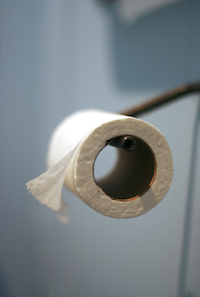Those of us over a certain age (and those of us lucky few with old homes and their own plumbing know-how) remember how we dealt with body waste in the old days.

We’d flush. And everything would go away. EVERYTHING! Well maybe Teddy would get stuck but anything you intended to get rid of vanished. That’s because we used to have toilets of the correct size for the job.
Then came the creeping federal regulations. Like most things the government screw up it started out as a good intention and a belief that we’re too stupid to work in our own best interests. Because some places had water shortages, it was decreed that everyone should have smaller toilets, dribbling showers and smaller sinks. One of the downsides of their meddling was that it forced Americans to give up their thick cushioned toilet paper (the envy of the world at that time) and to introduce pathetic toilet cisterns.
Since 1994, when the Energy Policy Act came into effect, we’ve had to install and suffer low-flow (1.6 gallon) residential toilets. Before that, toilets typically used at least 3.5 gallons of water per flush.
Anyone under 30 knows that toilets get blocked all the time, we have to use gauzy prison-grade toilet paper and every home has a plunger close to the toilet bowl. That extra couple of gallons makes a big difference. Once upon a time the stains were blasted off the porcelain, the smell was whooshed around the bend.
At first, we looked North to the Great White Toilet Provider in Canada. A market developed but the government got in the middle by levying fines of $2,500 for any plumber in the US who installed a big toilet, and forcing plumbing inspectors to report them. Black markets developed. You could briefly buy large tank toilets online, but those ran out. Now you have to haunt old houses looking for pre-1994 models and install them yourself.
And why? According to the inestimable Jeffrey Tucker at FEE:
What was the purpose of all of this? We are told often about how much water we are saving. What we are not told is that domestic water use in general, according to the Department of the Interior, is 1 percent of total water use. That includes your dishwasher, washing machine, showers, drinking water, toilets, and even watering grass. In other words, the savings is negligible and essentially pointless.
And look at the cost! The whole thing is outrageous. If you and I do not have a toilet that works super well in our own homes, something has gone very wrong with the state of civilization itself. As long as the technology is available, and we are willing to pay for it, it is a human right.
 So what are we to do? The Squirrel says: Make sure the water valve is fully open as a partially closed water valve can affect the fill performance of the tank. Turn the valve counterclockwise with your hand until it stops. Some models require only a quarter turn, while others need several full rotations to fully open.
So what are we to do? The Squirrel says: Make sure the water valve is fully open as a partially closed water valve can affect the fill performance of the tank. Turn the valve counterclockwise with your hand until it stops. Some models require only a quarter turn, while others need several full rotations to fully open.
You should also make sure your toilet has as much water in the tank as possible. You can do this by adjusting the float. For models that have a ball float, turn the screw on top of the fill valve clockwise to raise the water level. For models that contain a cylinder float valve attached to the fill valve, squeeze the clip on the side of the float and pull the float up until the water reaches the desired level.
Check your rims! Water flows into the toilet bowl from the tank through small holes on the underside of the toilet rim. They can get clogged with lime and other nastiness. Check the holes with a mirror and scrub the underside of the toilet bowl rim with a stiff brush to dislodge clogs and increase the overall flush performance.
You can employ air pressure. Vacuum suction systems like the ones on airplanes and cruise ship are available but they’re pricey. How about a pressure-assist toilet? These pressurized toilets have a bladder that holds water under pressure, delivering a more powerful flush – at a steeper price.
A recent development has been the Bluetooth smart toilet. If you thought having the NSA watching you was bad enough before now, imagine if they hack into your throne!
